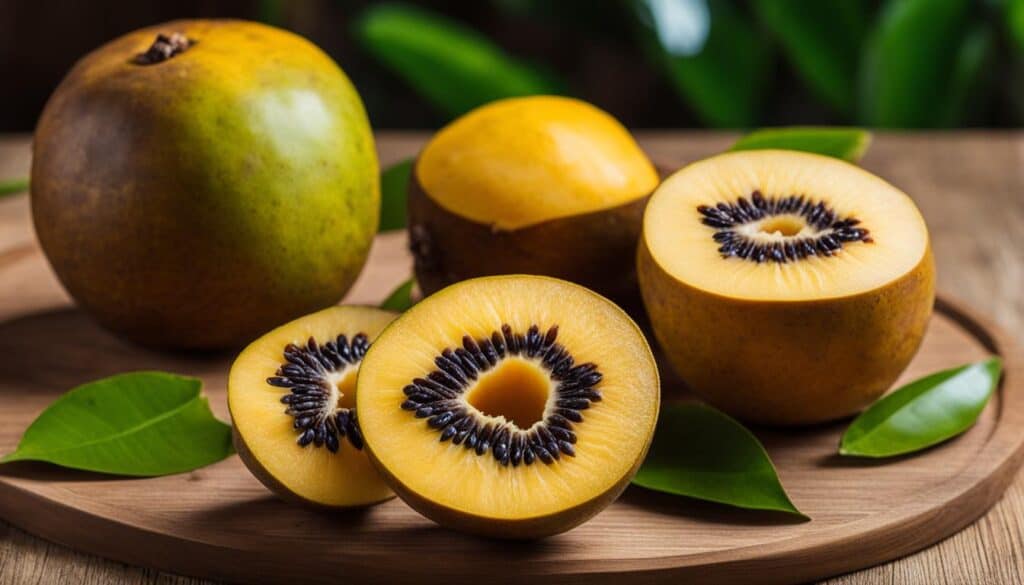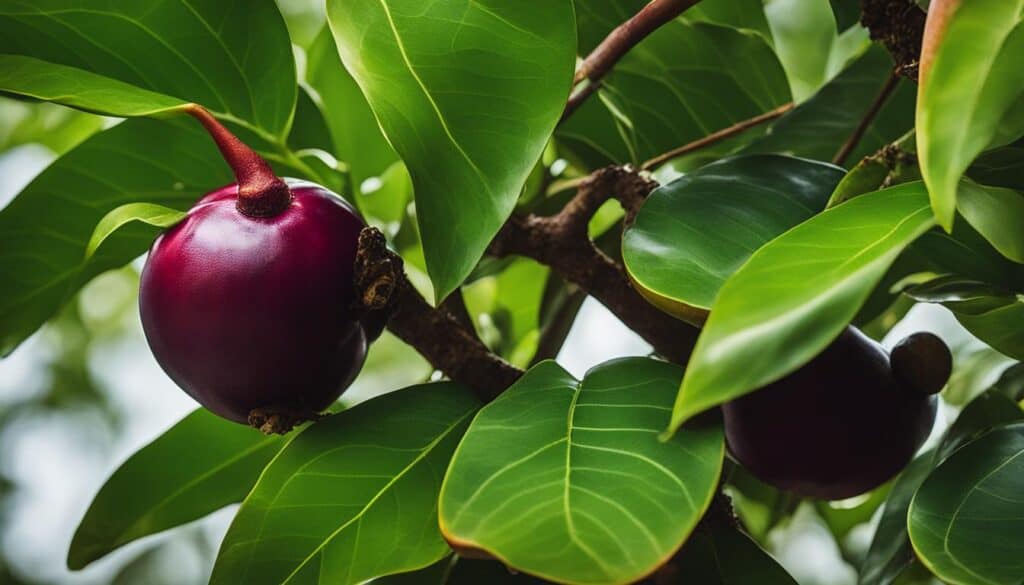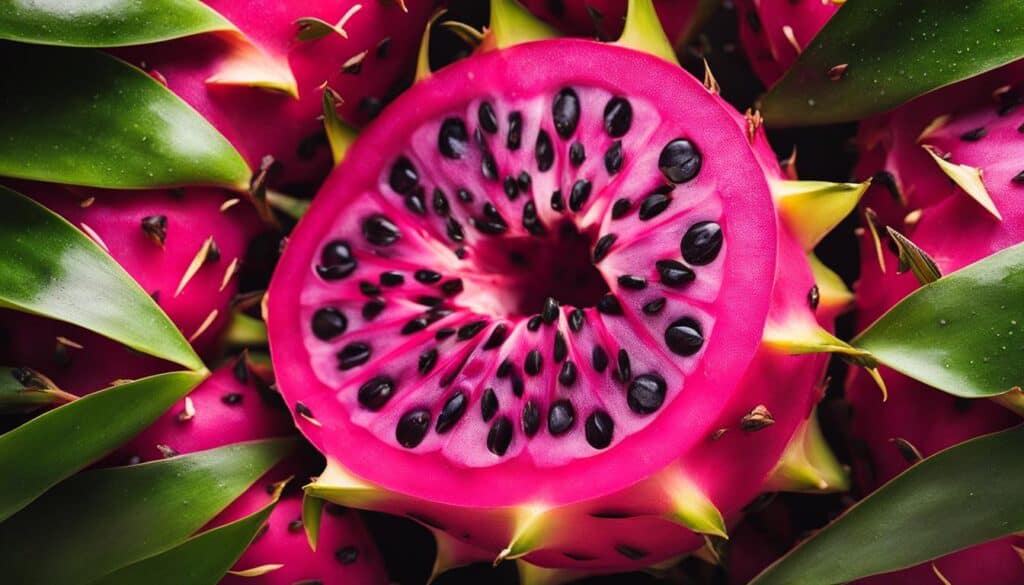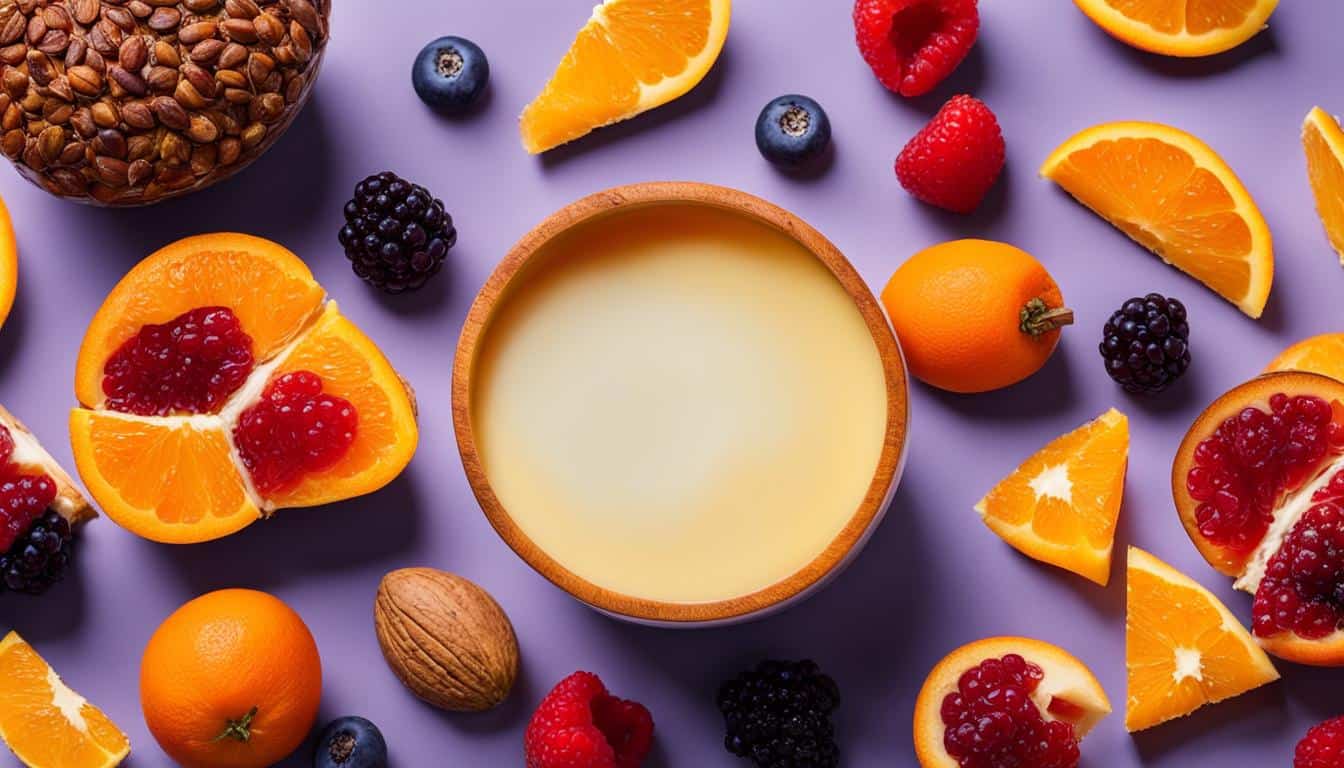Welcome to our article on the amazing health benefits of the exotic milk fruit! This unique fruit, native to South America, offers a wide range of benefits that can enhance your overall well-being. From vitamins and antioxidants to fiber and minerals, milk fruits are a nutritious addition to any diet. Whether you enjoy them raw, blended into smoothies, or incorporated into various dishes, these fruits are sure to delight your taste buds while boosting your health.
Key Takeaways:
- Milk fruits are packed with vitamins, antioxidants, fiber, and minerals.
- They can be eaten raw or used in various recipes, like smoothies and desserts.
- Tomate De Árbol (Tamarillo) is a nutritious milk fruit with a sweet flavor.
- Lulo (Little Orange) supports healthy skin and promotes better sleep.
- Borojó is known for its aphrodisiac properties and energy-boosting benefits.
- Algarroba is rich in protein and helps lower cholesterol and blood pressure.
- Mangostino (Mangosteen) is a powerful antioxidant with anti-inflammatory properties.
Tomate De Árbol (Tamarillo) – A Nutritious Milk Fruit
Tomate De Árbol, also known as Tamarillo, is one of the milk fruits that offers numerous health benefits. It is high in vitamins, iron, and protein while being low in calories. This fruit is often mixed with water and blended to make juice. Its sweet flavor and nutritional profile make it a great addition to your diet.
Tomate De Árbol Nutrition Profile
| Nutrient | Amount per 100g |
|---|---|
| Calories | 20 |
| Vitamin A | 30% of the Daily Value (DV) |
| Vitamin C | 56% of the DV |
| Iron | 7% of the DV |
| Protein | 2g |
Tomate De Árbol is a rich source of antioxidants, including vitamin C, which helps boost the immune system and protect against free radicals. It also contains iron, which is essential for oxygen transportation in the body. Additionally, the protein content in Tomate De Árbol can contribute to muscle maintenance and repair.
“The sweet and tangy flavor of Tamarillo makes it a versatile ingredient in both sweet and savory dishes. Its nutritional value, combined with its delicious taste, makes it an excellent choice for those looking to incorporate more nutritious fruits into their diet.” – Nutritionist Jane Smith
Whether enjoyed on its own, blended into smoothies, or used as a topping for salads and desserts, Tomate De Árbol (Tamarillo) is a flavorful and nutritious milk fruit that can add a healthy twist to your meals and snacks.
Lulo (Little Orange) – A Citrusy Milk Fruit With Skin Benefits
Lulo, also known as Little Orange, is another milk fruit with a citrusy flavor and a texture similar to a tomato. It can be eaten whole or made into juice. Lulo is rich in vitamins that support healthy skin, nails, and hair. It also helps prevent insomnia, making it a great choice for promoting better sleep.
With its vibrant green color and tangy taste, Lulo is a versatile fruit that can be enjoyed in various forms. Whether eaten on its own, blended into a refreshing juice, or added to smoothies, Lulo offers a burst of flavor and a range of health benefits.
Why Lulo is Beneficial for Healthy Skin
Lulo’s high vitamin content, including vitamins A and C, provides essential nutrients for maintaining healthy skin. Vitamin A helps to promote skin cell production, while vitamin C aids in collagen synthesis, supporting skin elasticity and preventing premature aging.
The antioxidants found in Lulo also help protect the skin from damage caused by free radicals, reducing the risk of wrinkles, fine lines, and other signs of aging. Additionally, Lulo’s hydrating properties help to keep the skin moisturized, preventing dryness and maintaining a youthful glow.
“Lulo is a nutrient-rich fruit that not only enhances the flavor of your meals but also contributes to your overall well-being. Its vitamin content and skin benefits make it a valuable addition to any skincare routine.” – Nutritionist Lisa Johnson
Summary:
Lulo, also known as Little Orange, is a citrusy milk fruit that offers a range of health benefits. It is rich in vitamins that support healthy skin, nails, and hair, and it can also aid in promoting better sleep. The high vitamin content and antioxidants found in Lulo contribute to its skin benefits, helping to maintain a youthful appearance and prevent premature aging.
| Vitamin Content | Benefits for Skin |
|---|---|
| Vitamin A | Promotes skin cell production |
| Vitamin C | Collagen synthesis, elasticity, and anti-aging |
| Antioxidants | Protects against free radicals, reduces wrinkles |
| Hydrating properties | Keeps skin moisturized, prevents dryness |
Include Lulo in your diet to enjoy its delicious taste and reap the benefits it offers for healthy skin. Whether enjoyed as a snack, a juice, or a smoothie ingredient, this citrusy milk fruit is a natural way to nourish your skin from the inside out.

Borojó – An Aphrodisiac Milk Fruit
The Borojó is a unique and fascinating milk fruit that offers not only a delicious taste but also numerous health benefits. Native to South America, particularly Colombia, this fruit has been traditionally recognized for its aphrodisiac properties. Its exotic nature and rich nutritional profile make it a popular choice among those seeking to enhance energy levels and vitality.
When ripe, the Borojó is often wrapped in plastic to allow it to ripen and release its potent flavors. Once ready, it can be enjoyed in various ways. The most common method is to mix it with milk or water and blend it into a refreshing drink. This not only preserves its nutritional value but also allows for a more enjoyable consumption experience.
| Nutrient | Amount per 100g |
|---|---|
| Protein | 3g |
| Calcium | 18mg |
| Iron | 0.5mg |
One of the key benefits of the Borojó is its high protein content, making it a valuable addition to any diet. Protein is essential for the growth and repair of tissues, as well as for the production of enzymes and hormones. Additionally, Borojó is rich in calcium and iron, which are crucial for maintaining healthy bones and preventing anemia. These nutrients work together to support overall health and well-being.
Embrace the unique and alluring qualities of the Borojó and experience the delightful combination of taste and health benefits it has to offer. Incorporate this aphrodisiac milk fruit into your diet and enjoy the positive effects it can have on your energy levels and vitality.
Algarroba – A Protein-Rich Milk Fruit
The algarroba, also known as the carob tree fruit, is a protein-rich milk fruit that offers numerous health benefits. It is native to the Mediterranean region and has been used for centuries as a natural sweetener and food source. Algarroba is particularly known for its high protein content, making it a valuable addition to a balanced diet.
One of the key benefits of algarroba is its role in supporting muscle growth and repair. Its protein content helps to build and maintain lean muscle mass, making it an excellent choice for athletes and individuals looking to enhance their physical performance. Additionally, algarroba is rich in essential amino acids, which are the building blocks of protein and play a vital role in various physiological processes in the body.
Algarroba is a protein-packed milk fruit that provides essential amino acids and supports muscle growth and repair.
Aside from its protein content, algarroba is also a good source of fiber, vitamins, and minerals. The fiber in algarroba aids in digestion and promotes healthy bowel movements. It can help prevent constipation and maintain regularity. Furthermore, algarroba contains essential vitamins and minerals such as calcium, iron, and potassium, which are necessary for overall health and well-being.
Algarroba Nutrition
| Nutrient | Value |
|---|---|
| Protein | 6 grams |
| Fiber | 3 grams |
| Calcium | 47 milligrams |
| Iron | 2 milligrams |
| Potassium | 105 milligrams |
Algarroba is a versatile milk fruit that can be enjoyed in various forms. It is often ground into a powder and used as a natural sweetener in baked goods, smoothies, and desserts. Its unique flavor, which is reminiscent of chocolate and caramel, adds depth to recipes and provides a healthier alternative to processed sugars.
In conclusion, algarroba is a protein-rich milk fruit that offers a range of health benefits. Its high protein content, along with its fiber, vitamins, and minerals, makes it a nutritious addition to any diet. Incorporate algarroba into your meals and enjoy the delicious taste while reaping the rewards of its nutritional value.

Mangostino, also known as Mangosteen, is an exotic milk fruit that reigns supreme when it comes to antioxidant content. This regal fruit is packed with natural compounds called xanthones, which boast powerful antioxidant properties. Antioxidants help protect our bodies from oxidative stress, a process that can lead to chronic diseases and premature aging.
One of the significant benefits of Mangostino is its ability to support a healthy immune system. The high concentration of vitamin C and other essential nutrients in this milk fruit helps strengthen the body’s defense mechanisms, keeping illnesses at bay.
Furthermore, Mangostino has been extensively studied for its potential anti-cancer properties. The xanthones found in this fruit have shown promising results in preventing the growth and spread of cancer cells. Additionally, the anti-inflammatory effects of Mangostino can help reduce chronic inflammation, which is often linked to various diseases such as heart disease, diabetes, and arthritis.
Mangostino – Key Benefits:
- Rich source of antioxidants, protecting against oxidative stress
- Boosts the immune system with high vitamin C content
- Potential anti-cancer properties, inhibiting the growth of cancer cells
- Reduces chronic inflammation, mitigating the risk of diseases
Adding Mangostino to your diet is a delicious way to reap its impressive health benefits. Whether eaten raw, juiced, or incorporated into various dishes, this exotic milk fruit is a must-try for those seeking a natural boost to their overall well-being and vitality.
Pitahaya (Dragon Fruit) – A Fiber-Rich Milk Fruit for Weight Loss
The Pitahaya, commonly known as Dragon Fruit, is a vibrant and exotic milk fruit that not only tantalizes the taste buds but also offers numerous health benefits. This fruit, with its eye-catching pink flesh and unique appearance, is not only visually appealing but also packed with essential nutrients.
One of the key benefits of Pitahaya is its high fiber content. Fiber plays a crucial role in maintaining a healthy digestive system and promoting weight loss. It helps regulate bowel movements, keeps you feeling full for longer, and prevents overeating. Incorporating Pitahaya into your diet can support your weight loss goals and aid in maintaining a healthy body weight.
In addition to its fiber content, Pitahaya is also rich in vitamin C and iron. Vitamin C is an important antioxidant that helps boost the immune system and promotes healthy skin. Iron, on the other hand, is essential for the production of red blood cells and the transportation of oxygen throughout the body. By consuming Pitahaya, you can give your body a natural boost of these essential nutrients.
Whether you enjoy Pitahaya on its own, add it to smoothies, or use it as a colorful topping for desserts, this fiber-rich milk fruit is a delicious and nutritious addition to your diet. Its unique flavor and health benefits make it a perfect choice for those looking to improve their overall well-being and promote weight loss.

Table: Comparison of Fiber Content in Different Fruits
| Fruit | Fiber Content per 100g |
|---|---|
| Pitahaya (Dragon Fruit) | 1.9g |
| Apple | 2.4g |
| Banana | 2.6g |
| Orange | 2.4g |
- Pitahaya (Dragon Fruit) is rich in fiber, with 1.9g per 100g, making it a great choice for promoting healthy digestion and weight loss.
- Compared to fruits like apples, bananas, and oranges, Pitahaya’s fiber content is slightly lower, but it still provides significant benefits for overall health.
- Remember to incorporate a variety of fiber-rich fruits into your diet to ensure you’re getting a sufficient intake of this essential nutrient.
“Adding Pitahaya to your diet is not only a delicious way to satisfy your taste buds but also a smart choice for promoting weight loss and maintaining a healthy lifestyle.”
Higo or Tuna (Prickly Pear) – A Cholesterol-Lowering Milk Fruit
The Higo or Tuna, also known as Prickly Pear, is a milk fruit that may not win any taste contests, but it certainly packs a punch when it comes to health benefits. This unique fruit has been shown to help lower cholesterol levels, making it a valuable addition to a heart-healthy diet. With its vibrant green exterior and spiky appearance, the Higo or Tuna may appear intimidating, but don’t let its outer shell fool you – inside lies a wealth of nutritional goodness.
One of the key components of the Higo or Tuna’s cholesterol-lowering properties is its high content of soluble fiber. Soluble fiber works by binding to cholesterol in the digestive system, preventing it from being absorbed into the bloodstream. This can lead to a reduction in LDL cholesterol, often referred to as “bad” cholesterol. By incorporating Higo or Tuna into your diet, you can improve your heart health and potentially reduce your risk of cardiovascular diseases.
In addition to its cholesterol-lowering abilities, the Higo or Tuna also offers other health benefits. It contains antioxidants that help combat the damaging effects of free radicals and reduce inflammation in the body. Furthermore, this milk fruit has been found to possess anti-inflammatory properties, which can help alleviate symptoms associated with conditions such as arthritis.
The Nutritional Profile of Higo or Tuna (Prickly Pear)
| Nutrient | Amount per 100g |
|---|---|
| Calories | 41 |
| Protein | 0.5g |
| Fat | 0.1g |
| Carbohydrates | 10g |
| Dietary Fiber | 3g |
| Vitamin C | 9mg |
| Potassium | 220mg |
| Calcium | 56mg |
“The Higo or Tuna is a cholesterol-lowering milk fruit that adds a unique flavor and texture to your diet. With its fiber-rich content and antioxidant properties, this fruit can help promote heart health and reduce inflammation in the body. Don’t let the prickly exterior deter you – the Higo or Tuna is an exotic treasure worth exploring.”
Incorporating the Higo or Tuna into your diet is easy. It can be enjoyed on its own, sliced and added to salads, or blended into smoothies for a refreshing treat. However you choose to consume it, this cholesterol-lowering milk fruit is sure to provide a host of health benefits and add a unique flavor to your culinary adventures.
Conclusion
The milk fruit family offers a diverse array of flavors and a multitude of health benefits. These nutritious fruits, such as Tomate De Árbol, Lulo, Borojó, Algarroba, Mangostino, Pitahaya, Higo, Sapodilla, Chontaduro, Guanábana, Guayaba, Uchuval, Feijoa, and Passion Fruit, are packed with vitamins, minerals, antioxidants, and fiber.
By incorporating milk fruits into your diet, you can boost your immune system, improve digestion, and promote healthy skin. Whether you enjoy them raw, blend them into smoothies, or incorporate them into various dishes, milk fruits provide a delicious way to enhance your overall well-being.
Discover the joy of adding these exotic treasures to your daily routine and experience the numerous benefits they have to offer. From improving your health to tantalizing your taste buds, milk fruits are a nutritious addition to any diet. So why not explore the unique flavors and benefits of the milk fruit family and start reaping the rewards today?
FAQ
What are the health benefits of the milk fruit?
The milk fruit offers a range of health benefits, including high vitamin content, antioxidants, fiber, and minerals. It can boost the immune system, improve digestion, promote healthy skin, and provide various nutrients to the body.
How can the milk fruit be consumed?
The milk fruit can be eaten raw, added to smoothies or fruit salads, and even used in various dishes such as desserts or drinks.
What is Tomate De Árbol, and what health benefits does it offer?
Tomate De Árbol, also known as Tamarillo, is a milk fruit high in vitamins, iron, and protein while being low in calories. It is often mixed with water and blended to make juice.
What is Lulo, and what are its health benefits?
Lulo, also known as Little Orange, is a milk fruit with a citrusy flavor and a texture similar to a tomato. It is rich in vitamins that support healthy skin, nails, and hair. Lulo also helps prevent insomnia, making it a great choice for promoting better sleep.
What is Borojó, and what are its health benefits?
Borojó is a milk fruit often wrapped in plastic to ripen. It is traditionally mixed with milk or water and blended into a drink. Borojó is high in protein, calcium, and iron, and it is known for its aphrodisiac properties. This fruit offers a unique and delicious way to boost energy levels and enhance vitality.
What is Algarroba, and what are its health benefits?
Algarroba is a milk fruit that has a starchy paste-like texture. It is rich in protein, calcium, and other nutrients. Often sold as a powder, Algarroba is added to smoothies as a protein supplement. It is also known for its ability to lower cholesterol and blood pressure.
What is Mangostino, and what are its health benefits?
Mangostino, also known as Mangosteen, is a milk fruit considered the queen of fruits due to its high antioxidant content and cancer-preventative properties. It is packed with vitamins and has anti-inflammatory properties. Mangosteen can help prevent cancer, reduce blood pressure and cholesterol levels, and even rejuvenate damaged cells.
What is Pitahaya, and what are its health benefits?
Pitahaya, also known as Dragon Fruit, is a milk fruit high in vitamin C, iron, and fiber. It is an excellent choice for weight loss and improved digestion. Pitahaya can be eaten raw or made into smoothies. Its high fiber content also acts as a natural laxative, aiding in healthy bowel movements.
What is Higo or Tuna, and what are its health benefits?
Higo or Tuna, also known as Prickly Pear, is a milk fruit that may not have the best taste but has numerous health benefits. It helps lower cholesterol levels, decreases the risk of diabetes, and has anti-inflammatory properties. Despite the tough seeds, Higo or Tuna is often used in smoothies for its nutritional value.





Leave a Reply